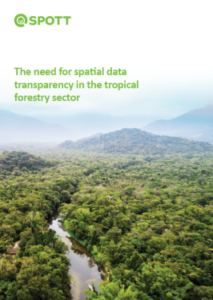The world’s remaining forests are being degraded and lost at a dramatic pace: it is estimated that each second, more than one hectare of tropical forest, an area slightly larger than a standard football pitch, is affected by forest loss or forest degradation.
The forest products industry is a major driver of forest disturbance. From 2001 to 2015, global forest disturbance was attributed to four main causes: commodity-driven deforestation (27%), forestry (26%), shifting agriculture (24%) and wildfire (23%).1 Ensuring the sustainability of forestry operations is therefore critical to preserve the biodiversity of forests and their capacity to provide natural resources, livelihoods, and other ecosystem services locally and globally.
From the mapping of complex supply chains across multinational companies through to local level monitoring of activities in the field, spatial data is a key tool to improve our understanding of drivers of forest degradation and biodiversity loss.
Transparency in the forestry sector – including publicly available and suitable spatial data about company operations – can play a key role in facilitating improved monitoring of forestry activities, increasing knowledge of supply chain impacts, and ultimately strengthening sustainability in the forestry sector.
This report presents the case for spatial data disclosure by forestry companies. It provides guidance on the collection, disclosure and use of spatial data. It highlights the benefits of spatial data transparency to companies and wider stakeholders, including financial institutions and buying companies, who rely on accurate, consistent and transparent information to support their lending, investment and procurement decisions.
1 Curtis, P. G., Slay, C. M., Harris, N. L., Tyukavina, A., & Hansen, M. C. (2018). Classifying drivers of global forest loss. Science, 361(6407), 1108-1111.

